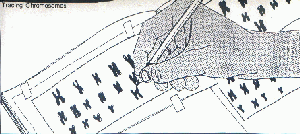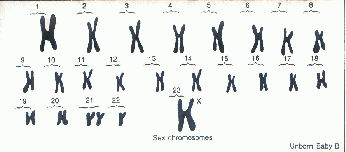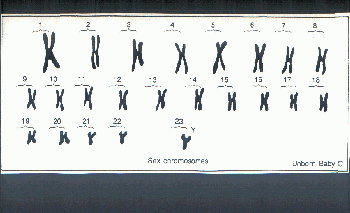
SUMMER RESEARCH PROGRAM FOR SECONDARY SCHOOL SCIENCE TEACHERS
LESSON PLAN
Freddy A. Cedeno
Aim: How can you predict the characteristics of an unborn baby?
Motivation: What will the sex of your next unborn family member be?
Objective: Students will be able to explain the function of karyo-typing
I - Lecture: Define (10 minutes)
A- Chromosome
B- Chromatid
C- Centromere
D- Haploid Number
E- Diploid Number
F- Set Chromosome
G- Mutation
H- Genetic Disease
I - Karyotype
*Use double helix model.
[Content Standard C- The Cell]
II- Group Project: 3 students in each group (25 minutes).
Give students three sets of unlabeled human chromosomes. (1 male, 1 female, 1 abnormal-trisonomy 21).
Students are to compare the three sets of chromosomes and gather the data related to the define terms. (form a table).
III- Report: (5 minutes)
A- Sex, differences of each, normal/abnormal.
B- Karyotype of each.
How Do the Chromosomes of Unborn Children Look?
Normal babies have 46 chromosomes in each cell. They have 22 pairs of chromosomes and one pair of sex chromosomes in each cell. If the chromosome number varies, or chromosome pairs do not match, the baby may be born with a birth defect. [Content Standard C- Molecular basis of heredity]A birth defect is a physical or mental problem present at birth.
It is possible to check a baby's chromosomes before it is born. When the baby's chromosomes are checked, fluid from around the baby is removed. The cells in the fluid are grown and then examined for chromosomes. The chromosomes are photographed. The chromosomes in the photograph are then cut out, paired, and examined. Thus, parents can find out if their baby may not be normal at birth. [Content Standard F- Personal health]
GOALS: In this exercise, you will:
a. trace chromosomes to pair them.
b. pair chromosomes and make observations about
them.
MATERIALS: plastic sheet wax
pencil
PROCEDURE: Trace the chromosomes shown at the top of page 202 onto the plastic sheet using the wax pencil. Make sure that you trace the edges of the box around the chromosomes also. Be sure that you do not move the plastic sheet while you are tracing.



